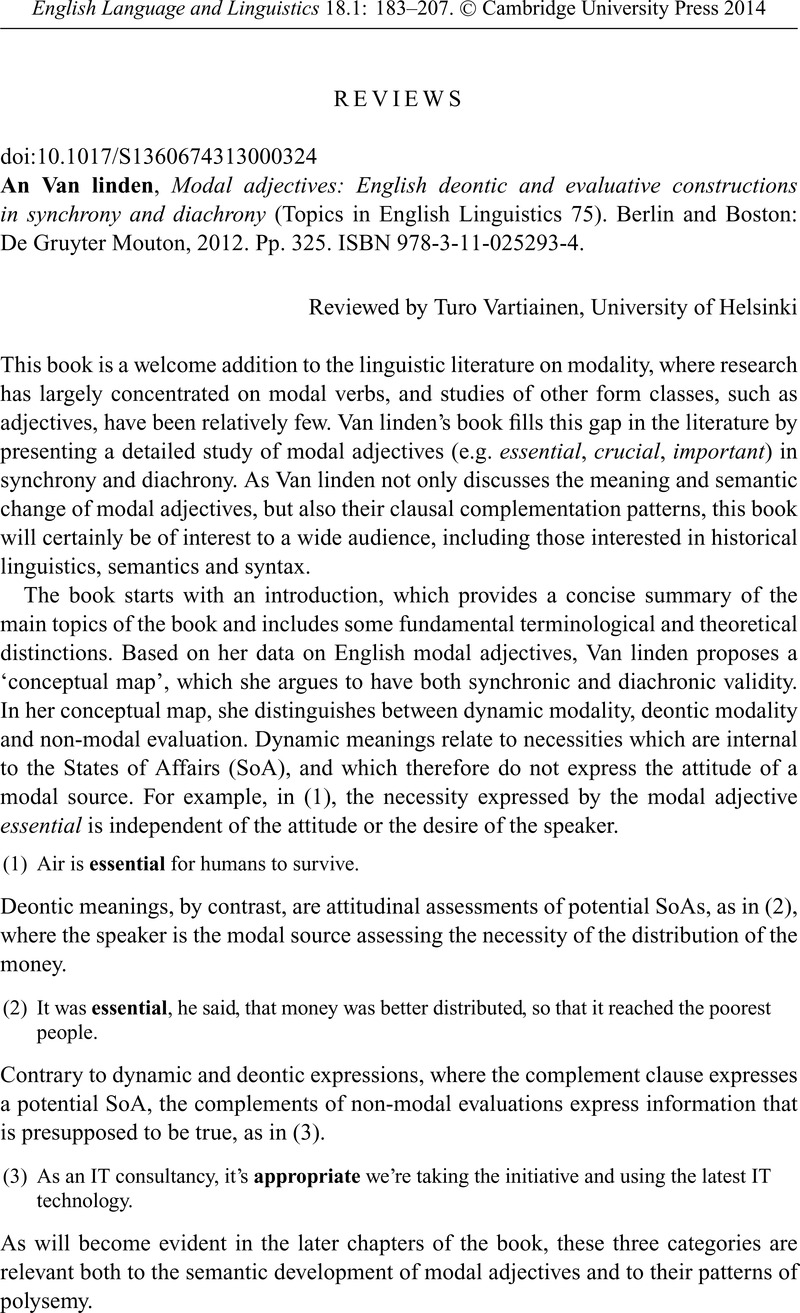No CrossRef data available.
Article contents
An Van linden, Modal adjectives: English deontic and evaluative constructions in synchrony and diachrony (Topics in English Linguistics 75). Berlin and Boston: De Gruyter Mouton, 2012. Pp. 325. ISBN 978-3-11-025293-4.
Published online by Cambridge University Press: 06 February 2014
Abstract
An abstract is not available for this content so a preview has been provided. Please use the Get access link above for information on how to access this content.

- Type
- Reviews
- Information
- Copyright
- Copyright © Cambridge University Press 2014
References
Collins COBUILD Corpus. Distributed by HarperCollins via the Collins COBUILD WordbanksOnline service.Google Scholar
De Smet, Hendrik. 2006. The Corpus of Late Modern English Texts (Extended Version). Department of Linguistics, University of Leuven.Google Scholar
ECCO – Eighteenth Century Collections Online. Thomson Gale. www.gale.com/EighteenthCentury/.Google Scholar
Goldberg, Adele. 1996. Construction Grammar. In Brown, Keith & Miller, Jim (eds.), Concise encyclopedia of syntactic theories, 68–71. New York: Pergamon.Google Scholar
Kroch, Anthony, Santorini, Beatrice & Delfs, Lauren. 2004. The Penn–Helsinki Parsed Corpus of Early Modern English (PPCEME). Department of Linguistics, University of Pennsylvania. CD-ROM, first edition. www.ling.upenn.edu/hist-corpora/.Google Scholar
Kroch, Anthony & Taylor, Ann. 2000. The Penn–Helsinki Parsed Corpus of Middle English (PPCME2). Department of Linguistics, University of Pennsylvania. CD-ROM, second edition. www.ling.upenn.edu/hist-corpora/.Google Scholar
Los, Bettelou. 2005. The rise of the to-infinitive. Oxford: Oxford University Press.CrossRefGoogle Scholar
Rohdenburg, Günther. 1995. On the replacement of finite complement clauses by infinitives in English. English Studies 76 (4), 367–88.CrossRefGoogle Scholar
Stefanowitsch, Anatol & Gries, Stefan T.. 2003. Collostructions: Investigating the interaction of words and constructions. International Journal of Corpus Linguistics 8 (2), 209–45.CrossRefGoogle Scholar
Taylor, Ann, Warner, Anthony, Pintzuk, Susan & Beths, Frank. 2003. The York–Toronto–Helsinki Parsed Corpus of Old English Prose (YCOE). Department of Linguistics, University of York. Oxford Text Archive, first edition. www-users.york.ac.uk/~lang22/YcoeHome1.htm.Google Scholar
Traugott, Elizabeth Closs. 1989. On the rise of epistemic meanings in English: An example of subjectification in semantic change. Language 65 (1), 31–55.CrossRefGoogle Scholar


